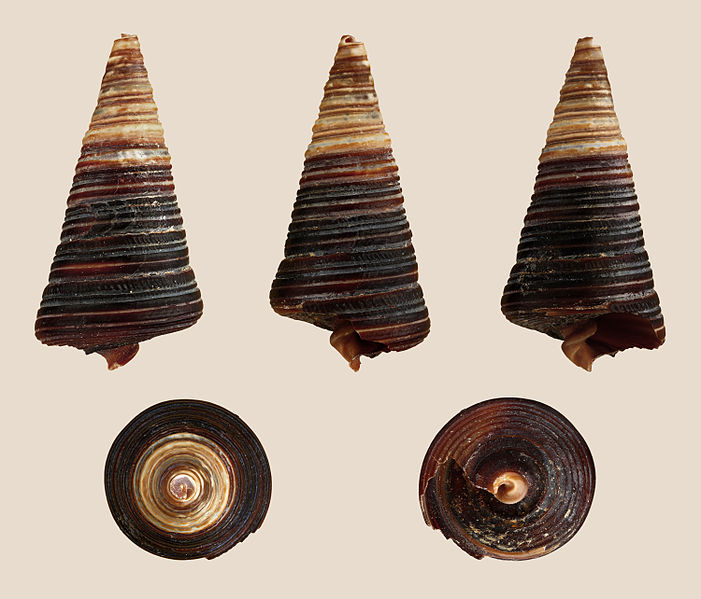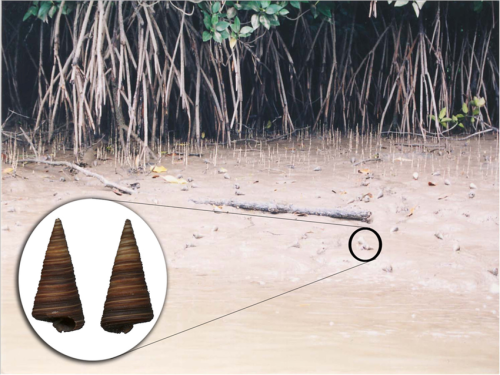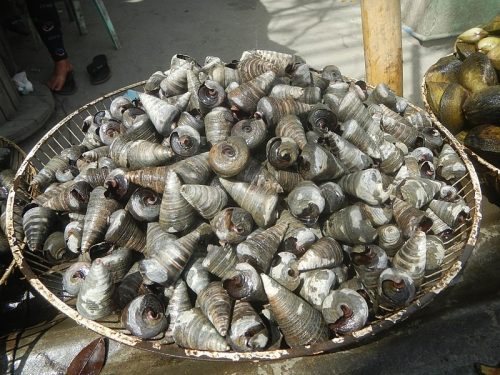Telescopium: The Fascinating Horn Snail

Photo Credit : H. Zell/Wikimedia
Telescopium is a species of snail that belongs to the horn snail family, Potamididae. Also known as the telescope snail, they are commonly found in mangrove habitats in the Indo-Pacific region.
Scientific Classification
|
Kingdom: |
Animalia |
|
Phylum: |
Mollusca |
|
Class: |
Gastropoda |
|
Family: |
Potamididae |
|
Genus: |
Telescopium |
|
Species: |
Telescopium telescopium (Linnaeus, 1758) |
This species is easily recognizable by its cone-shaped shell. The outer part of the shell is equipped with spiral lines and is blackish-brown in color. They are large snails that can grow up to 9.3 cm in length in mangrove forest areas, and in fish ponds, they only measure 8.8 cm. The size of the shell can vary due to the availability of food in mangrove forest areas are better than in fish ponds.
Telescopium inhabits muddy soil near the tide, and can live for some time outside of water. The respiratory system of Telescopium works in the same way as other semi-tidal gastropods, in that it gets oxygen from water passing over small gills located inside its shell. When the tide goes out, the Telescopium will withdraw into its shell, reserving energy and oxygen until the ebb tide phase returns and they become active again.
“Ebb tide” refers to the period when the sea level falls over several hours, revealing the intertidal zone. This is the phase of the tide during which the water level is falling. The reverse flow, occurring during rising tides, is called the "flood tide". These tidal movements are crucial for various marine and coastal life forms as they influence feeding and breeding patterns. They also play a significant role in shaping coastal landscapes.
Benefits to the Ecosystem
Telescopium are detritivores. Mangrove forest floors are where Telescopium predominantly acquire their nutrients to function, where they feed on the rich decomposed organic matter that is left behind during the ebb tide phase of tidal movements and surface algae. They also only scavenge for food when covered completely or partially with just their shell tips exposed as a means of protection against heat, desiccation, and predators.
In addition to deforestation and marine pollution, microplastics have become a big threat to Telescopium. A study was undertaken to examine the effects on Telescopium and the results showed a correlation between an increase in mass and level of ingested microplastics in the digestive organ, and inhaled in the respiratory system. The most common type of microplastic found in the Telescopium was fiber, followed by fragments.

Photo Credit : Bapi Gorain
Benefits to Humans
Telescopium are known as food in some parts of Southeast Asia. They also have high nutritional content and are useful for asthma medicine. In addition, they can also be used as handicraft materials.
Studies have been undertaken that suggest Telescopium tissue, when ingested, can act as central nervous system depressants. This study is still under investigation as tests have not yet passed in-vivo tests taken on rodents, however, all rodents that consumed Telescopium tissue demonstrated the symptoms associated with central nervous system depressants.

Photo Credit ; Judgefloro/Wikimedia
As a Pest
Although Telescopium has many benefits, they can also become pests, especially in shrimp cultivation. However, research is being conducted to find effective ways to control their population.
In conclusion, Telescopium is an interesting species with various benefits and challenges. They are an important part of the coastal ecosystem and further knowledge about them can assist in conservation and management efforts.

